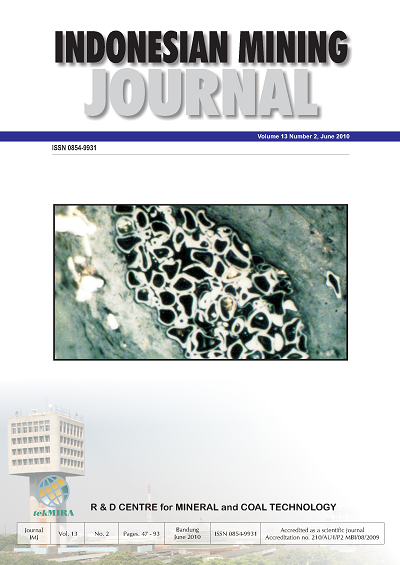Indexed by:
Vol. 13 No. 2 (2010): INDONESIAN MINING JOURNAL Vol. 13 No. 2 June 2010

Law No. 4/2009, new law of mineral and coal mining in Indonesia has already been implemented since 2009. The issuance of the law has an impact to the management of mineral and coal mining operations throughout this country, because the law results in lots of new issues that are associated with regional autonomy. Such as contradictive to the previous issued law, namely Law No. 11/1967 regarding the centralized main guidelines on mining. Moreover, most of regional governments are not ready enough to implement the new law due to lack of qualified human resources, technology, infrastructure, interest conflict on land use and so forth. Accordingly, a lot of new mining investors are reluctant to have business in exploiting mineral and coal in Indonesia. This is a bad news for the government that wishes to attract the investors to invest their capital in mining sector. The important issues on mineral and coal mining include policy, environment and safety, investment, energy-mix and illegal mining. The policy issue relates to the tightness of the mining environ- ment, particularly in the implementation of the analysis of environmental impact. The mineral and coal technology papers in this journal are emphasized to improve the quality of products. This is in accordance with the new law, in which the mineral and coal must be processed to result in value added.
Marble waste and fly ash were utilized for fine ceramic raw materials. Both materials were obtained from textile industries around Bandung area. In addition, clay as a formed agent for the ceramic body was used. The characteristic results indicate that composition of 70% of clay, 10% of marble waste and 20% of fly ash provide the best result.
Trends in supply/demand for Indonesian coal period 2005-2025 are presented in this journal. It is strongly warned to the government that the mineable coal reserve will probably be finished for approximately 18 years. Additionally, the coal-steamed powers that operate until now has an age of 26 years. When the reserve is not well-managed, it will immediately be finished in the shorter time. Accordingly, it requires an anticipative step of a policy concept that can maintain a sustainability of the domestic coal stock by implementing a limited export.
Coal Water Fuel (CWF) is one of energy diversifications. This enables coal to substitute fuel oil by existing installation, because CWF can flow similar to the flow of liquid. Selections of additive, coal size fraction, ratio coal and water of CWF were investigated in a laboratory scale. Results of using different size fraction show that concentration decrease and penetration rate from CWF with size fraction of -200 mesh is relatively constant compared to the CWF of -60 mesh.
Palaeogene coals from Southern Banten were investigated according to their petrographic properties. Evalua- tion that they tend to have similar petrographic properties and were formed in the same environment. Some of the coals show the highest vitrinite content and higher rank due to an intrusive activity. The high content of mineral matter in the coals was influenced by marine incursion during their deposition.
Kalimantan coal quality was evaluated to select appropriate and effective utilization technologies. Coal qual- ity including coal petrology in terms of type and rank, mineral content, hardgrove grindability index, sodium content can contribute to an understanding of the nature and aids in determining its utilization potential. The low-rank coal can be developed through various utilization technologies like coal upgrading, hot water treat- ing coal slurry, coal liquefaction, carbonization and mine-mouth power plant.
After assessing all the above papers, it is clearly understandable that the new law of mineral and coal mining has totally support to improve the value added of these commodities. The applied technologies resulting in those commodities need to be shared and implemented to the users/industries in order to fulfill their com- modities demand. Therefore, dependence on import could be stopped in the future.
The Editor











